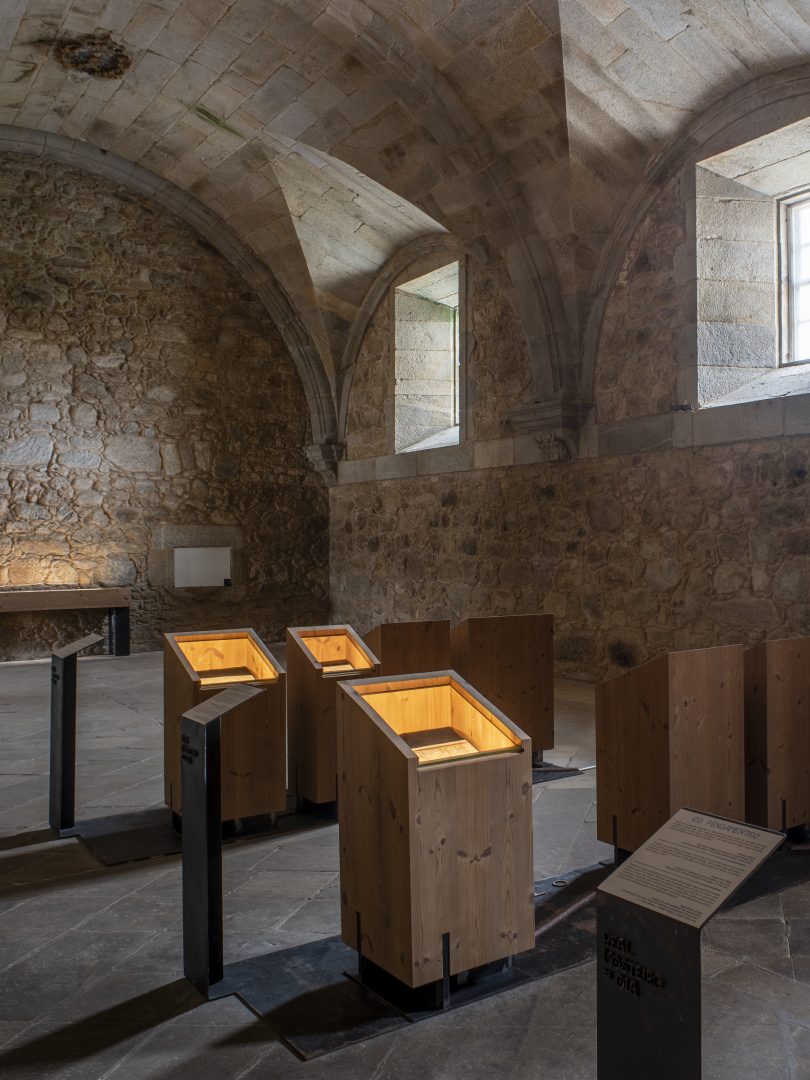Nos gusta pensar que la Arquitectura habita en un difuso Lugar entre la razón y el sentimiento. Ahí encuentra su razón de ser, se convierte en algo apasionante y se diferencia de los ejercicios de encaje normativo para convertirse en mucho más.
En el convencimiento de que es ahí desde dónde debemos habitar como profesión, como arquitectos siempre buscamos ese espacio difuso y desde ese lugar en ocasiones surgen verdaderos regalos a modo de encargo. No son especiales por su volumen o por su presupuesto, son especiales por lo que significan y por qué nos permiten intervenir en un LUGAR que representa todo lo anterior. Un lugar con una Atmósfera tan potente que ya sólo queda entenderla, respetarla.
Si lo logramos, nuestro proyecto permitirá compartir y potenciar aquello que convierte al Lugar en especial.
Cada lugar del Monasterio de Oia -el único monasterio cisterciense a Orillas de Atlántico- es especial, cada lugar cuenta una historia y hemos tenido la suerte de escucharla por algunos de sus protagonistas.
El señor Castellá o el señor Luis ya no están entre nosotros, pero antes de dejarnos sí hemos tenido la suerte de escuchar como vivieron siendo casi niños esos años en los que el Monasterio era una prisión de la Guerra Civil. Uno desde dentro y otro desde el arrabal de Oia.
Y con esas historias en nuestra mochila personal, nos enfrentamos al diseño de un espacio expositivo que ponga en valor los increíbles dibujos de los presos del monasterio. Obras que sí conocíamos en detalle, pero que nunca habíamos podido recorrer en su totalidad en una misma jornada pues el corazón no podría encogerse más.
¿Cómo trasladar tantas vivencias, sufrimiento y esperanzas en un espacio que, como contenedor también debía ser puesto en valor?
La respuesta para nosotros estaba en la necesidad de hacer que la Arquitectura desapareciera para dar paso a la ATMÓSFERA. A ese aire que sí puede transmitir, respeto, silencio y calma.
Los elementos que hemos diseñado pueden verse como unos simple muebles, pero son Arquitectura; tan importante como cualquier otro objeto de mayor escala porque es nuestra manera de entender nuestra profesión.
Son una parte del monasterio, se relacionan con él desde la elección del material, desde sus dimensiones y su posición ceremonial, transmiten respeto al objeto expuesto, ordenan el recorrido y generan un ambiente que ayuda a crear una atmósfera.
Los dibujos son especiales y el contenedor debe ayudar a contar la memoria que transmiten y -con suerte- estar a la altura de lo que señor Salvador Castellá desearía encontrarse.
Quien sabe, quizás alguno de esos dibujos sea de él.
We like to think that Arquitecture lives in a dispersed space between reason and emotion. There it finds its place, it becomes something engaging and it sets itself appart from common piece matching to become so much more.
With our deep conviction on choosing that place to sojourn in our profession, we try to search for that dispersed space as architects, and from that position sometimes true gifts arise as assignments. They may not be special from its volume or budget, but they are unique for their meaning and for what they allow us to involve ourselves in a PLACE that represents all of what we belive. A place with a profound atmosphere that you only have to understand and respect.
If we achieve it, our project will allow to share and enhance that wich makes this place special.
Every corner in Oia’s Monastery -the only cistercian monastery on an Atlantic coast- is special, every place tells a story and we’ve been lucky to hear it from some of its main characters.
Mr. Castellá or Mr. Luis are not longer between us, but before they left us we are grateful for hearing how they lived being almost children on those years during the civil war where the monastery served as a prison. One from the inside and the other from the Oia’s suburbs.
And with those stories on our personal backpack we face the design of a display space that takes into account the incredible drawing from the monastery’s inmmates. Works that we knew in detail, but that we could never tour as a whole on a single day because a heart can`t struggle that much.
How to move so much life experiences, suffering and hope on a space that as a capsule had to be taken into account itself?
The answer for us was on the need of making the spaces architecture dissapear to give place to its atmosphere. To that air wich can convey respect, calm and quiet.
The elements we designed can be understood as simple forniture, but they are Architecture; as important as any other bigger scale object because thats our understanding of our profession.
They are a part of the monastery, they relate to it from the material selection, its dimmensions and its ceremonial dispossition try to transmit respecto to the work exposed. They give order and create an ambience that helps create the space’s atmosphere.
The drawings are special and the vessel needs to help tell the story they transmit an -luckily- be up to what Mr. Salvador Castella would like to encounter.
Who knows, maybe one of those drawings is from him.
privado
ARQUITECTO TÉCNICO: Miguel Barriga García
FOTÓGRAFO: Héctor Santos
Premiados en la edición “Gran de Area 2021” de aportación a la Arquitectura 2021








